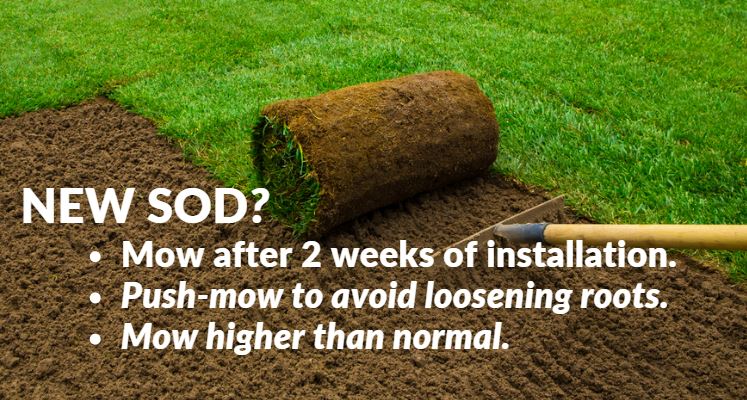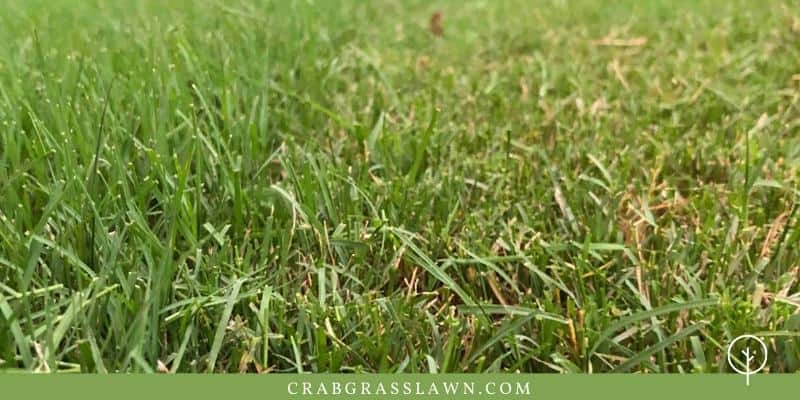Mowing your sodded lawn at the wrong time and frequency can easily damage your newly installed turf.
But when to mow new sod? I always mow new sod 7-14 days after installation. A simple rule of thumb: If you usually cut at 2″, then start cutting it when it reaches 2 1/2″. Be sure not to cut more than 1/3rd of the blade regardless of what height it is.
Here’s a guide on when to mow new sod and why it is important to adhere to the waiting time.
When to Mow New Sod
It’s a question many homeowners keep asking themselves, ‘How long can I wait before mowing my newly sodded lawn?’

Depending on the type of sod you’ve installed in addition to when you plant it, it is recommended that you wait for at least 7 days and up to 14 after the installation of new sod before mowing.
This will give your sod time to establish its strong roots in the soil for further growth. Mowing immediately after sodding is not good, as the sod’s root system is usually still narrow at this point to facilitate any new growth.
The best time to mow your sodded lawn is once the root system is established. You can determine this by pulling out and feeling a section of the sod for any signs of resistance. If there is, then it’s time to bring out your lawnmower!
Mowing Height for New Sod
You should mow your newly sodded lawn at a height that will still leave behind enough leaf surface area to adequately facilitate photosynthesis for the grass.
The ability of a perennial grass species to maintain photosynthetic production through mowing cycles is determined by various factors including the following:
- How long the internodes are
- How many rhizomes/stolons it has
- How many basal buds it has
These aspects determine turf grasses’ tolerance to low mowing heights since they’re responsible for leaf mass.
Different mowing heights for different grasses

With the factors varying in length and quantity for every turfgrass species, different turf grasses have different recommended mowing heights.
Kentucky bluegrass and fine fescues, for instance, cannot produce sufficient leaf mass when cut at very low heights, hence should be mowed at about 3 to 4 inches while they’re still new sod, which is relatively high.
On the other hand, bunch-type sods like Tall fescues and ryegrass produce just enough leaf mass to allow mowing heights of 2 to 3 inches of new sod.
Finding the correct mowing height will help your lawn grow thicker and fuller, preventing bare spots and weed competition. (See my detailed guide on making bermuda grass thicker here)
Mowing Height For New Sod Chart
| Kentucky Bluegrass | 1.5″-2″ | |
| Fine & Tall Fescues | 1.5″-4″ | |
| Zoysia | .5″-3″ | |
| Bermuda | .5″-2.5″ | |
| Bahia | 2.5″-4″ | |
| St. Augustine | 1.5″-2″ | |
| Centipede | 1″-2.5″ | |
| Ryegrass | .75″-2.5″ |
For best results, mow often enough so that no more than 1/3 of the grass blade is removed at each mowing session.
Care Tips Before Mowing Newly Planted Sod
Taking the proper steps after laying your new sod will ensure quick and strong rooting. Use these tips before you mow it for the first time.
Fertilize Before Mowing
After laying new sod, you will need to ensure it gets the proper fertilization. Research says that there’s no need to fertilize new St. Augustine grass sod for at least a month after installation. Lawnifi’s New Lawn Starter Box is a great all-around nutrition program that can help your sod get a healthy start. This is what I’ve been using on all new sod jobs that I put down. Check it out here.

You should apply starter fertilizer just before you start laying the sod. Spread this fertilizer on the ground before installing sod on top.
Watering before Mowing
Before you mow newly planted sod two weeks post-installation, you need to ensure that it stays adequately watered. The watering should start right after installation and should be done 2 to 6 times a day for 4 to 6 minutes at a time.
Ensure that you water the sod up to a depth of four-six inches to keep the lawn adequately damp and spongy. You can determine whether you’ve watered to the appropriate depth by lifting the corner of a single sod.
Avoid foot traffic
Another crucial care tip for newly sodded lawns is to avoid stepping on the lawn to give it time to take root. Walking on the lawn while it’s still spongy will leave behind footstep depressions, resulting in uneven growth and an unsightly lawn.
More water in summer
Adding to this, if you’re planting during hot summer days, you can let your sprinklers run for more than the 3 to 5-time watering frequency recommended above. This is because, in hot weather, the sod dries out faster, causing it to turn brown, shrink, and dry out.
Furthermore, frequent watering helps new sod take root faster, as the moisture facilitates faster soil penetration for the sod roots. After doing this for 14 days, it’s now time to mow your lawn for the first time.
Caring for New Sod after Mowing

After you mow the first time, watering is key.
Reduce the watering frequency
From the third week after installation, and after the first mowing, it’s now time to gradually start reducing the watering frequency. You should switch to watering no more than thrice per day.
Water the lawn on alternate days
If the sod has already firmly taken root, it’ll likely not dry out even if it goes unwatered on some days.
At this point, you can decide to only water your new lawn on alternate days. By the fourth week, the watering frequency should have gone down to twice a day, every second day. After a month, you can bring the frequency further down to once every three days.
Run sprinklers in the mornings and evenings
We recommend running your sprinklers early in the morning and late in the evenings when there’s minimal evaporation. Additionally, you can split up each watering session into two; running the sprinklers in two one-hour intervals; to give the water enough time to penetrate heavy soils and consequently facilitate deep root growth.
Also see our Oscillating Sprinkler Guide
Benefits of Mowing Your Newly Planted Lawn
Mowing is a vital part of developing a healthy lawn. As soon as you start cutting the turfgrass the right way, you’ll notice the following benefits:
- Mowing helps your lawn grow thicker and fuller faster.
- Mowing frequently helps most lawns choke out weeds such as crabgrass.
- In some cases, cutting newly sodded lawns can help prevent and get rid of insects such as grass spiders.
When you mow your newly sodded lawn, significant portions of the grass leaves that facilitate photosynthesis are cut off, forcing the plant to regrow the leaves while also sprouting more shoots.
These new shoots translate into an increased surface area/turf density. High-density grass turf is considered good quality turf.
For home lawns – for instance – the goal is usually to increase the turf density for increased wear tolerance. A high-density turf can tolerate foot traffic without losing its lush color. As for sports turfs, high-density turf is desirable since it increases the turf’s playability.
Additionally, frequent mowing helps ‘condition’ your turf grass to develop shorter shoots, as the species adapts to avoid significant sections like the crown getting chopped off.
With shorter shoots, less root establishment is required to support the grass plants. This translates into simpler lawn care and maintenance routines, as less water is consequently required to establish the root system.
Bag or Mulch After Mowing New Sod?
The answer depends on personal preferences, but I like to put my grass clippings to work by leaving them to mulch on my lawn. This process called grasscycling reduces the time it takes to rake and bag the clippings and provides essential nutrients for your lawn.
When to Mow New Sod with Riding Mower?
Sod does provide an instant lawn but remember it takes time for it to grow strong roots. Wait for roughly three weeks after sod installation to mow with a riding lawn mower fitted with sharp mower blades.
Make sure you adhere to proper watering techniques during this time and keep tabs on how the sod is growing.
FAQs
How Long Does It Take for Sod to Root?
Sod takes approximately 10 – 14 days after application to root. You can mow new sod once it has taken root but avoid cutting too close to the roots. For more information, you can check my detailed article on how long it takes for sod to take root.
How Do You Know if Sod Is Rooted?
A good technique to check whether sod is ready to mow with a riding lawnmower is by tugging on a small section gently. If it comes right up, don’t mow but if there’s some resistance, you can go ahead and mow with your riding lawnmower.
What if I Waited Too Long to Cut My Sod?
If you wait too long to cut sod, it will overgrow and will look untidy. But that’s not all, overgrown sod can attract weeds, pests, and disease so it’s important to cut sod no more than ⅓ each time you mow.
How Long After Installing Sod Can You Walk On It?
Just like mowing, you should wait about two weeks before walking on new sod. This number of days vary depending on whether the sod has taken root.
Final Thoughts
The right time to mow new sod is after it has grown strong deep roots. To ensure sod rots grow well after installing sod properly, refrain from shallow watering but deep watering is required until the soil is saturated but not puddling.
Next: See The Best Time of Day To Mow Your Lawn
Hi, Alex Kuritz here. Growing up I remember that my family had one of the best lawns in the neighborhood. Richly green and lush. I did a lot as I grew up in terms of caring and tending for not only my family’s lawn but also my neighbors. I can say I have years of experience, and I am here to share it with you.



Good afternoon Sir,
A man cut my newly sod lawn and now I have brown spots. What should I do.
Hi Georgia, thanks for writing in. First I’m sorry to hear that someone cut your yard too short. Depends on how short, hopefully not too low. Feel free to join our Facebook group here so you can upload a pic or two and we can see what you have going on: https://www.facebook.com/groups/LawnAndLandscapingHacks/.
Do i need to rake cut grass anymore after two months established??
HI Suzanne, thanks for commenting and sorry for the delay. For anyone else reading this, after two months the grass should be well rooted. Also depends on the time of the year. If over the summer it should be good to go.